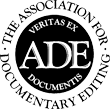"Will not these days be by thy poets sung": Poems of the Anglo-African and National Anti-Slavery Standard, 1863–1864
Edited by Elizabeth Lorang and R. J. Weir |
 |
 |
 |
| page 1 | page 2 | page 3 | page 4 |
 View Poem Image
View Poem ImageFull size in new window
FOR THE ANGLO-AFRICAN.
LINES
Cleveland, Ohio.
LINES
ON THE DEATH OF PRESIDENT LINCOLN.[1]
At morn, upon the startled wire,
Like lightning,[2] flashed the tragic tale;
Business is hushed—lips now are dumb,
Eyes are bedimmed, and cheeks turn pale.
Tell us, O God! can this be true,
Is our great statesman dead?
Palsied be the traitor's arm,
That thus, his life-blood, shed.
O, tell us, will his manly voice,
In Senate halls, be heard no more?
His deeds of kindness, words of love,
Are they, on earth, now o'er?
I pause to wipe the scalding tears,
Which down my cheeks now freely steal;
The cruel thought I cannot bear—
With horror now my senses reel.
Friend of humanity, thy name
Is sounded forth, from every hill;
'Tis wafted on the morning breeze,
And murmured mid the bubbling rill.
'Tis echoed from the fettered slave,
As he offers up his evening prayer;
And when beneath the cruel lash,
'Tis freely whispered by him there.
'Tis stamped on every manly heart,
'Twill live while ages fade away;
Empires may rise and empires fall,
But still thy name shall hold the sway.
Let us now as one man rush forth,
And avenge our leader's cruel death!
Strike down the man who now shall dare
Pollute his name with traitorous breath.
Hurl from the earth yon tyrant bold,
And let us in his vile ears hiss;
The words which he so proudly spoke,
Sic semper tyrannis.[3]
Notes
- Abraham Lincoln (1809– April 15, 1865) was assassinated by John Wilkes Booth (1838–April 26, 1865), days after General Robert
E. Lee surrendered his Confederate Army to General Ulysses S. Grant at Appomattox Courthouse. A native of Maryland and a devotee
of the Confederacy, Booth shot Lincoln in the back of the head as he watched an evening performance of Our American Cousin at Ford's Theatre. At the same time, one of Booth's co-conspirators attacked Secretary of State William Seward at his home.
Lincoln died the following morning; the news turned Northern elation into shocked grief. Twenty-five thousand people came
to the White House to pay their respects as Lincoln's body lay in state (Drew Gilpin Faust, This Republic of Suffering: Death and the American Civil War[New York: Knopf, 2008], 156). Processions and gatherings took place across the country on the day of the funeral (April 19)
and at each stop on the corpse's subsequent journey to Springfield, Illinois. The funeral train reached Cleveland, Ohio, on
the morning of April 28; a procession accompanied the coffin to the city's Public Square, where a service was held. That evening,
the train continued to Columbus, Ohio. Lincoln was finally buried in Springfield's Oak Ridge cemetery on May 4.

- Telegraph wire. The comparison was well established: antebellum Americans referred to electric telegraphy as communication
by "lightning." See, for example, the telegraph operator's announcement "that Buffalo and New York are no longer separated—they
can talk to each other by lightning" (Scientific American, September 26, 1846, 5). Telegraphic bulletins (and the newspapers that printed them) quickly spread the news of Lincoln's
death, and within twelve hours, newspapers across the United States shared the story with their readers (Richard D. Brown,
Knowledge Is Power: The Diffusion of Information in Early America, 1700–1865 [New York: Oxford University Press, 1989], 258).

- "Thus always to tyrants"; assassin John Wilkes Booth shouted the classical phrase (also Virginia's state motto) moments after
he shot Lincoln.

- The Cleveland, Ohio, city directory for 1869 lists a Sarah Greenbrier as a teacher living at 98 Woodbine. Also living at the
same address was an Ann Greenbrier, seamstress (Cleveland Leader Annual City Director for 1869–1870 [Cleveland: Cleveland Leader Printing Company, 1869]). In the directory, Sarah is listed as being a boarder at the address.
The relationship between Sarah and Ann is unknown, but Ann may have been Sarah's mother, sister, sister-in-law (Ann was a
widow), or other relation. Additional information about Sarah is unknown; however, the federal census offers details about
Ann that may potentially help to illuminate Sarah's biography. The 1870 census lists her as "Anna Greenbrier," age fifty-four,
a white female born in Virginia whose occupation is "keeping house." Four other Greenbriers between the ages of twelve and
twenty-one also lived in the house at this time (Sidney, Mary, George, and Clarkson). The 1880 census identifies her as "Ann
Greenbrier," age sixty-four, born in Virginia to a Virginia-born mother and English-born father. Tellingly, Greenbrier's race
in the 1880 census was initially recorded as "W" for "white" and overwritten with "Mu" for mulatto. This fact, combined with
her identification as white in the 1870 census, suggests that Greenbrier and members of the family may have "passed" as white.
In the 1880 census, four children lived in Greenbrier's home: Sidney (son, 32), Mary (daughter, 30), Emma (daughter, 26),
George (son, 24), and Clarkson (son, 24). All the children were identified as mulatto. Sidney was employed as a sleeping car
conductor, George was a porter on the railroad, and Clarkson worked in a doctor's office. The occupation category identifies
daughters Emma and Mary simply as "at home."


